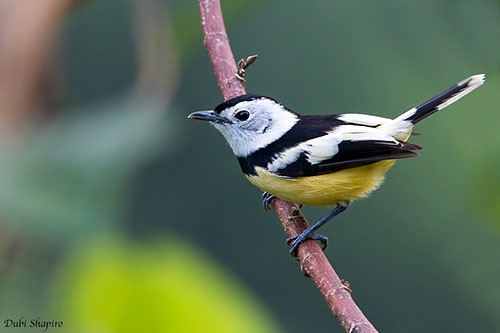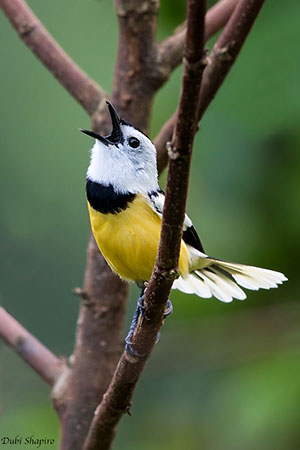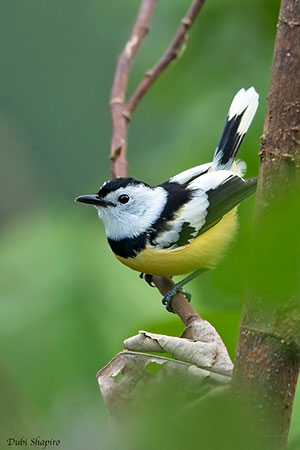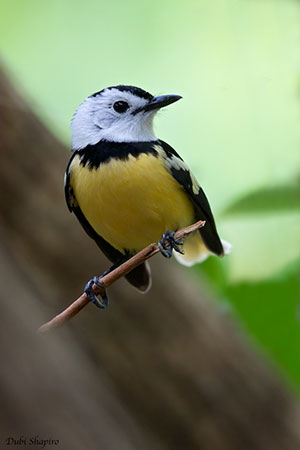
Fr: Monarque des Banks
Ang: Buff-bellied Monarch
All: Harlekinmonarch
Esp: Monarca de las Banks
Ita: Monarca panciacamoscio
Nd: Harlekijnmonarch
Sd: vanuatumonark
Photographer:
Dubi Shapiro
Dubi Shapiro Photo Galleries & Dubi Shapiro's Pictures on IBC
Text by Nicole Bouglouan
Sources:
HANDBOOK OF THE BIRDS OF THE WORLD Vol 11 by Josep del Hoyo, Andrew Elliott and David Christie - Lynx Edicions - ISBN: 849655306X
L’ENCYCLOPEDIE MONDIALE DES OISEAUX - Dr Christopher M. Perrins - BORDAS - ISBN: 2040185607
Birds of Melanesia: Bismarcks, Solomons, Vanuatu and New Caledonia Par Guy Dutson – Editeur : Bloomsbury Publishing, 2011 – ISBN: 1408152460, 9781408152461
CREAGUS - MONARCHS Monarchidae
Wikipedia, the free encyclopaedia
TheWebsiteOfEverything - Buff-bellied Monarch
Encyclopaedia Britannica – Monarch bird
Buff-bellied Monarch
Neolalage banksiana
Passeriformes Order – Monarchidae Family
INTRODUCTION:
The Buff-bellied Monarch was formerly placed in the genus “Lalage” with the trillers, in the family Campephagidae. It is now placed in its own genus “Neolalage” in the family Monarchidae. It is endemic to Vanuatu where it lives in forested habitats. It feeds on insects by hoping from branch to branch.
The Buff-bellied Monarch is a poorly known species. It has restricted range in which it is apparently fairly common, and the population is currently stable.
DESCRIPTION OF THE BIRD:
Biometrics:
Length: 15 cm
The Buff-bellied Monarch has white head, except the black band extending from central forehead and crown to nape.
The bill is black. The eyes are dark brown to blackish. Legs and feet are dark greyish blue.
On the upperparts, mantle and upper back are black. Rump and uppertail-coverts are creamy-white. The tail is black, with creamy tips, more extensive on the outermost rectrices. On the upperwing, the primary flight feathers are black, whereas other remiges are white. Wing-coverts and tertials are orange-buff to creamy.
On the underparts, the black breast band is conspicuous. Lower breast and belly are orange-buff to creamy-white. The undertail is creamy-white, not black.

The female resembles male, but she is duller with less white on the upperwing.
The juvenile shows similar pattern, but the upperparts are mostly brownish-black with dark mottling on face and wings and greyish rather white areas. The bill is yellowish.
RANGE:
The Buff-bellied Monarch is common in Banks Islands and Vanuatu (S to Efaté).
HABITAT:
The Buff-bellied Monarch favours wooded habitats including primary forest and secondary growth. It often frequents gardens in villages, and dense humid scrub. The species occurs from sea-level to 1,200 metres of elevation.
CALLS AND SONGS: SOUNDS BY XENO-CANTO
The Buff-bellied Monarch is noisy sometimes. It produces animated chatter when in pairs, some raspy, harsh “tzea” often repeated. We can also hear a drawn-out, thin, quavering whistle “treereeeeee”. The song is melodious.

BEHAVIOUR IN THE WILD:
The Buff-bellied Monarch is an insect-eater. It forages actively from middle levels to lower canopy, hoping from branch to branch and making short flights.
It perches horizontally while gleaning prey from the foliage. Flying insects can be caught by short sallies. It often cocks its tail while foraging.
The Buff-bellied Monarch is generally seen alone or in pairs, but small groups occur sometimes and it often joins mixed-species flocks. It often hides in the vegetal cover.
The courtship displays are unknown. But we can suggest that the rich coloured plumage pattern is enhanced by adapted postures. The cocked tail displays the black and white tail pattern. Displays are probably accompanied by songs.
The Buff-bellied Monarch is sedentary.
It is very agile in flight while foraging for insects.

REPRODUCTION OF THIS SPECIES:
The breeding season takes place between August and January. The Buff-bellied Monarch builds a conical cup in an upright fork of small tree, between 2 and 5 metres above the ground. This structure is made with rootlets, small twigs and tendrils of climbing plants. The cup is usually unlined.
The female lays 2 creamy-white eggs with dark markings. Incubation and nestling periods are unknown, but in the family Monarchidae, the incubation lasts between 13 and 17 days, and the chicks fledge approximately 12-18 days after hatching. But more information is required.
PROTECTION / THREATS / STATUS:
The Buff-bellied Monarch has restricted range on some islands. It is fairly common in suitable habitat, but less common in mountainous areas.
The species is poorly known, but the population is apparently stable and not globally threatened. The Buff-bellied Monarch is currently evaluated as Least Concern.
